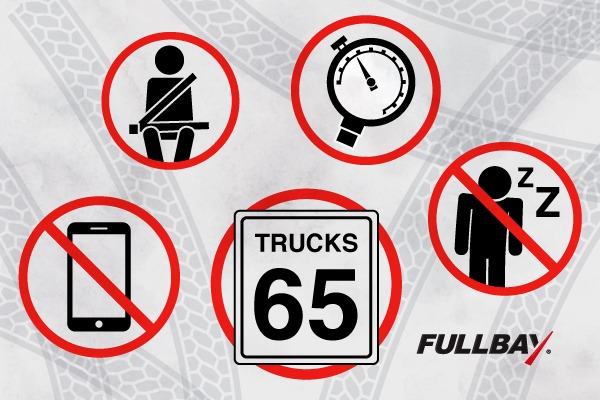How to Improve Safety in Trucking

According to the Federal Motor Carrier Safety Administration (FMCSA), heavy duty trucks were involved in nearly 450,000 crashes in 2017. Self-driving trucks may improve truck driving safety and decrease the number of wrecks however, the number of human-driven trucks on the road still outnumber autonomous ones. Yet, there are steps drivers can take to be safer and reduce accidents now. Our list of tips is a useful place to start and can help semi drivers stay safe on the road.
Truck Driving Safety 101: Maintain Your Truck
Truck driving safety starts with your rig. Make sure your truck is well-maintained and that you don’t just go through the motions when doing your pre and post-trip inspections. Pay close attention to fluid levels, ensure your horn works, and test the brakes in addition to visually inspecting them. You have a lot depending on them working properly, including your very life, so it’s essential to make sure the brakes, along with the rest of your semi, works properly, and report any potential problems before driving. Also, visibility is vital, as well. Carry glass cleaner with you and keep all reflective strips, lights, windows, and mirrors as clean as possible.
Don’t Overlook Your Cargo
It’s important to pay attention to how cargo is loaded. Shifting cargo can make your trailer tip or fishtail around corners, so make sure the load is secured properly to keep everything in place during the trip. Also, tall stacks can cause problems, too. They make the load top-heavy which causes a tipping danger, and they create more drag on your semi. Not only will spreading the cargo out through all the usable space reduce your chances of tipping and improve truck driving safety, but it will also reduce drag which can help fuel efficiency.
Plan Ahead to Improve Truck Driving Safety
The fewer surprises you have while driving, the better. Try to get your schedule as early as possible, but at least a day in advance. That will give you a chance to plan your route, check the weather forecast, and review road conditions. If you know about issues that could affect timing, you can talk to dispatch and make any necessary adjustments. That will eliminate most surprises, reduce stress, and improve truck driving safety.
Be aware of routes that will take you through canyons or up and down mountain passes. Steep roads present some of the most difficult and dangerous driving conditions, so it will help you be prepared to know when you’ll have to travel those stretches and how long they are. Use your truck’s GPS to map out a route, but watch it during your drive, too. It will notify you of traffic troubles and recommend different routes. However, you’ll still need to keep an eye out for road signs. GPS won’t necessarily tell you about clearance dimensions on bridges or through tunnels.
One part of pre-planning you might not be able to do is checking the delivery spot. When you arrive at your destination, park your truck and get a look at the dock for yourself. Take notice of ditches, posts, or fire hydrants or other objects that could interfere with you backing in and safely making it out again. It’s better to arrange for an alternative unloading point than to get stuck at the dock or have an accident trying to back into an impossible spot.
Belt Up
The law requires truck drivers to wear their seatbelts while driving but, unfortunately, 1 out of 6 truckers don’t belt up. Even for those who know seatbelt use is one of the top truck driving safety tips, proper use is essential for preventing or reducing injuries. The belt should sit across your hips rather than riding on your stomach. The shoulder strap should lie across your ribs and shouldn’t press on your neck. Use your seatbelt correctly to ensure a comfortable fit, and don’t pull the shoulder strap behind your arm. Remember, your truck’s manufacturer can provide a seat belt extender if you need more room.
ABC—Always Be Cautious
Truck driving safety requires being alert at all times and drive defensively. Constantly scan the road behind, on the sides, and in front of you, and expect the unexpected. When looking ahead, study the area about a quarter of a mile ahead of you, and keep an eye out for work zones, traffic jams, and other safety hazards. Check your mirrors several times each minute and try to be aware of vehicles in your blind spots. Respect other drivers, but remain cautious around them. Most motorists don’t know how to drive safely around semis. Be watchful and try to anticipate their actions, such as a car darting in front of you to take an exit. It’s less likely to come as a surprise or cause an accident if you’re prepared for the worst.
Watch Your Speed
Staying in control of your speed is essential, but in many cases that can only be done if you keep an eye on the signs. Speed limits change as you move from rural to urban areas, and they also change from state to state. Don’t pass by a speed limit sign without noting the number and adjusting your speed accordingly. Although driving the limit is essential to truck driving safety, there are a lot of times when you’ll need to go even slower such as:
- when going around curves
- when entering an interstate
- in work zones
Weather is another issue that affects how fast you can safely drive in a semi, and we’ll cover that next.
Truck Driving Safety Relies on Being Weather Aware
Weather impacts truck driving safety in many ways such as how your truck handles on the road and how quickly you can stop. In fact, weather conditions contribute to nearly 25 percent of truck accidents when speeding is involved. Check in on weather websites when planning your trip, but also be flexible enough to respond properly when you’re hit with unexpected conditions. Wet roads require you reduce your speed by one-third and you’ll need to cut it by one-half on icy, snowy roads.
Expected or not, weather can affect visibility, too. When rain, snow, and even fog interfere with your view of the road, pull off entirely, not just to the shoulder. That puts you and other drivers at risk. They may think you’re on the road and still moving and could mistakenly run into the back of your truck.
Give Yourself a Cushion
They call ‘em the big rigs for a reason. Your truck’s height and weight dwarf most other vehicles on the road. Plus, the mammoth size affects how much time and space you need to stop. For those reasons, you should maintain a buffer zone around your truck—a cushion of space that keeps you and other drivers safe. You need space above, below, in front, in back, and to both sides of your truck to stay clear of overpasses and tunnels, uneven or sloped roads, and objects in front, in back, and to the sides of you including other vehicles, toll booths, bridges, etc. Furthermore, trucks need a wide berth when making turns and backing up. Having a cushion helps ensure you won’t hit anything when executing those moves.
What’s more, if a semi needs to stop suddenly, it can’t. Four factors influence how long it takes a heavy duty truck to stop:
- Perceived distance—about ¾ of a second, the time it takes to see trouble ahead.
- Reaction distance—an additional ¾ of a second, the time it takes you to start putting your foot on the brake.
- Effective braking distance—roughly 4 seconds, the time it takes the truck to come to a stop after you applied the brake.
That adds up to almost 6 seconds. A semi going 55 mph will travel another 512 feet in that time. Plus, things like the weather, road conditions, and how loaded your truck is can make it take even longer (and farther) to come to a complete stop. That’s why the cushion and being aware are so critical for truck driving safety.
Pick a Lane
You already know your truck can’t maneuver like a Maserati, so it can’t gracefully dart from lane to lane. Try to stay in the same lane for most of your trip, only switching when necessary. Even then, truck driving safety relies on your utmost caution. Put your signal on and let it go for at least five blinks to let everyone know you’re changing lanes. Check your mirrors constantly during the move and be extra careful of your blind spots.
Also, try to keep away from cars merging onto the freeway. When you’re passing through a city, try to stay out of the right-hand lane, especially if you can see passenger vehicles entering the highway.
Truck Driving Safety at Night
Considering the increased risk night driving poses to truck driving safety, it’s a good idea to avoid driving after dark when you can. It’s not always possible, though, so when you must drive at night, exercise extra care. Make sure your windows and mirrors are clean. Wear corrective lenses (if you need them) or night vision glasses to make sure you see clearly. Listen to the radio or an audiobook to keep your mind from falling under road hypnosis. In some states, the speed limit changes after dark, so watch the posted signs carefully when driving after dark.
Dealing with Fatigue
The best way to deal with fatigue is to avoid it. Make regular stops to take breaks, but make unscheduled stops, too, if you need them. Get out of the cab to stretch and walk around, too, don’t just pull over for a few minutes. Also, if you’re sick, on medication, or drained to begin with, take some time off—even if it’s just a few hours or a day—rather than risking driving poorly. Preventive measures are excellent ways to avoid fatigue. Eat healthy, on and off the road. Exercise regularly and get plenty of sleep so you’re ready to hit the road when it’s time.
Some of these tips might seem like basic, common sense advice, but making a few adjustments and paying more attention while on the road can have a huge impact on truck driving safety. In the end, every step is worth it if it helps ensure your safety and that of the other drivers on the road.

